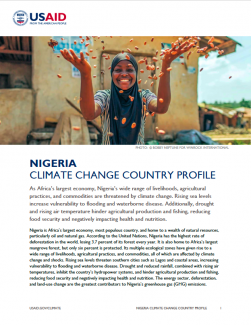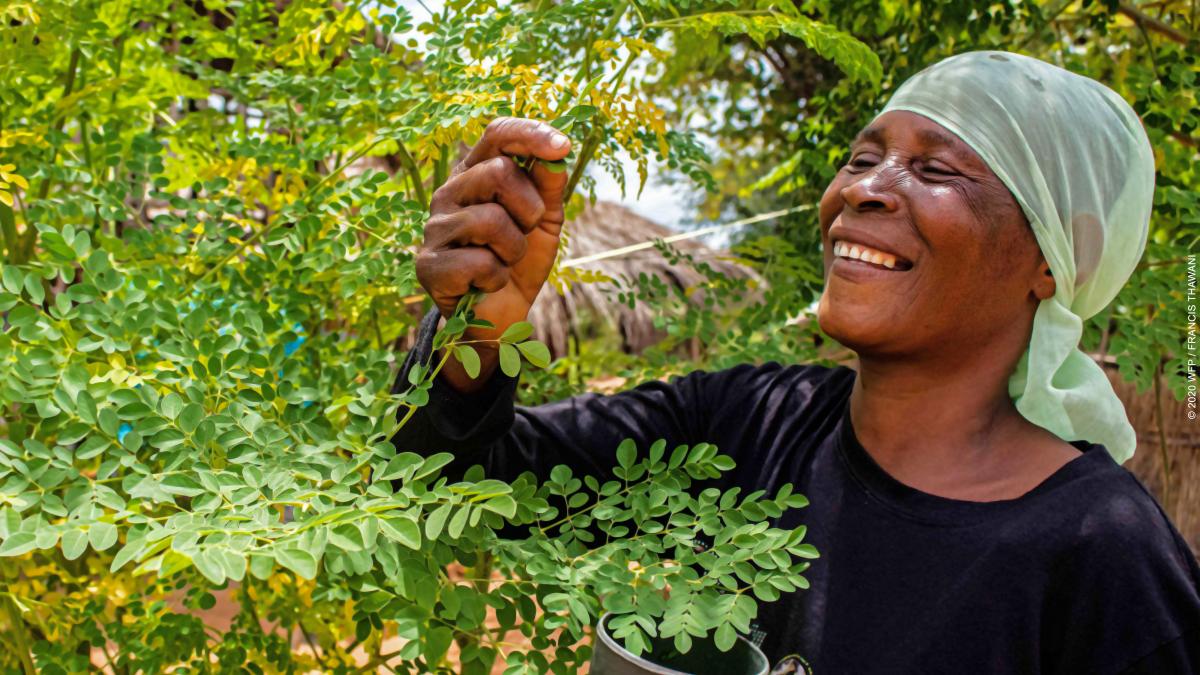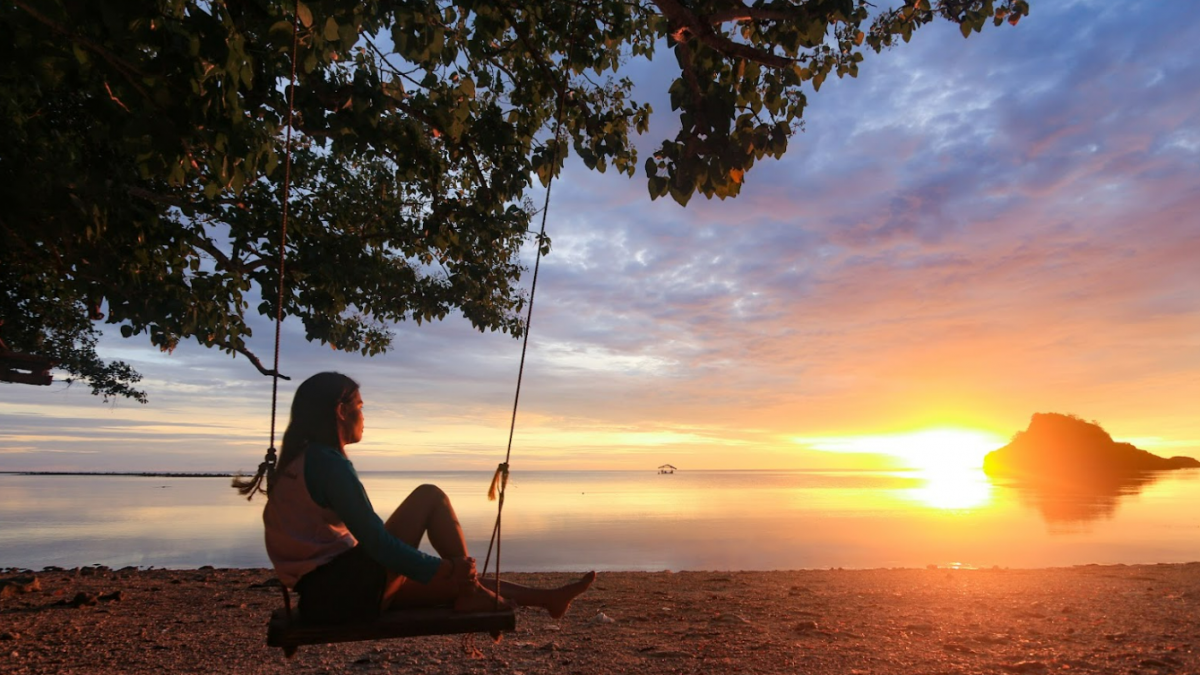As Africa’s largest economy, Nigeria’s wide range of livelihoods, agricultural practices, and commodities are threatened by climate change. Rising sea levels increase vulnerability to flooding and waterborne disease. Additionally, drought and rising temperature hinder agricultural production and fishing, reducing food security and negatively impacting health and nutrition.
Nigeria is Africa’s largest economy, most populous country, and home to a wealth of natural resources, particularly oil and natural gas. According to the United Nations, Nigeria has the highest rate of deforestation in the world, losing 3.7 percent of its forest every year. It is also home to Africa’s largest mangrove forest, but only six percent is protected. Its multiple ecological zones have given rise to a wide range of livelihoods, agricultural practices, and commodities, all of which are affected by climate change and shocks. Rising sea levels threaten southern cities such as Lagos and coastal areas, increasing vulnerability to flooding and waterborne disease. Drought and reduced rainfall, combined with rising air temperatures, inhibit the country’s hydropower systems, and hinder agricultural production and fishing, reducing food security and negatively impacting health and nutrition. The energy sector, deforestation, and land-use change are the greatest contributors to Nigeria’s greenhouse gas (GHG) emissions.
Government of Nigeria Climate Priorities
In 2021, the Government of Nigeria (GoN) updated its Nationally Determined Contribution (NDC) to the United Nations Framework Convention on Climate Change (UNFCCC) Paris Agreement, which establishes an unconditional contribution target of reducing greenhouse gas (GHG) emission reduction by 20 percent below the business as usual emissions scenario by 2030, and a conditional target of 47 percent GHG emission reduction below 2018 emissions levels contingent on international support. The 2021 NDC update includes emissions reduction from the waste sector for the first time, covers the water resources sector, and articulates other nature-based solutions. The National Council on Climate Change, established in 2021 by the Nigeria Climate Change Act, works to mainstream climate change actions and achieve low GHG objectives. Nigeria's National Adaptation Plan Framework (2020) articulates Nigeria’s adaptation objectives, principles that guide these adaptation actions, and facilitates the implementation of priority adaptation activities. The Nigeria Energy Transition Plan outlines Nigeria’s commitment to carbon neutrality by 2060 across 5 key sectors: power, cooking, oil and gas, transport and industry.
USAID’s Climate Change Program: Objectives and Results
USAID supports the GoN’s development and climate priorities through Power Africa, agricultural Feed the Future initiative interventions, and Water, Sanitation, and Hygiene programming.
Renewable Energy
About 70 percent of Nigeria’s primary energy supply is derived from biomass resources. Poor on-grid power supply, which rarely exceeds 5 gigawatts, forces Africa’s largest economy to rely on more than 14 gigawatts of inefficient petrol and diesel backup generators across the country, contributing to 30 percent of the fine particulate matter emissions from the continent. Nigeria aims to decrease the use of diesel generators for backup power by improving on-grid power generation and delivery from new gas, hydro and solar power projects and expanding access to solar home systems and mini-grids in rural areas. The U.S. Government’s Power Africa initiative, coordinated by USAID, is supporting the GoN’s efforts by unlocking stranded generation through improving on-grid transmission and distribution capacities, facilitating implementation of Nigeria’s Presidential Power Initiative to improve grid reliability, and supporting off-grid projects like the Solar Power Naija Program and the Nigeria Electrification Project, which will electrify millions through solar home systems and solar hybrid mini grids. These efforts support Nigeria’s Electricity “Vision 30:30:30” that aims to increase electric power generation from 5.5 gigawatts (GW) to 30 GW with 30 percent sourced from renewable energy resources by 2030.
Key Results
- Since 2018, the Power Africa initiative has supported the installation of 2.3 million on-grid metered connections, mobilized over $2.3 billion of public and private investment in the power sector, and supported a 2,420 megawatts (MW) increase in the grid evacuation capacity of the Nigerian transmission system, in collaboration with the Nigerian Ministry of Power, Nigerian Energy Regulatory Commission and other public and private sector partners.
- Since 2018, USAID/Power Africa also supported 2.4 million off-grid power connections in collaboration with the Rural Electrification Agency of Nigeria, the World Bank's Nigerian Electrification Program and 189 private sector partners. In 2022, Nigeria became the largest off-grid electricity market in Sub Saharan Africa.
- With significant technical assistance from USAID Power Africa, in 2023 the Nigerian government announced 42 winning bidders for its Gas Flare Commercialization Program, an innovative auction program meant to reduce the environmentally unfriendly practice of gas flaring. Per USAID's conservative calculations, these 48 sites flare 2.6 to 3.1 billion cubic meters of gas per day, 48 to 58 percent of Nigeria's total flared gas emissions as reported by the World Bank. Capturing this gas and using it to replace other fuels– for power generation, transportation and other industrial purposes– will reduce Nigeria's carbon emissions by 5 to 6 million metric tons of CO2 per year.
Key Renewable Energy Programs
- Power Africa Nigeria Power Sector Program: Works along the entire electricity value chain, from gas supply to new generation, improving transmission and distribution networks, off- grid renewable energy deployment, and improving the enabling environment.
Adaptation
USAID supports the GoN’s climate priorities by implementing resilience-building activities with a focus on vulnerable communities in ecologically-sensitive regions in Nigeria.
Key Results
- About 1 million smallholder farmers are implementing climate smart agriculture through the use of improved seed varieties, such as drought-tolerant and early maturing seed varieties.
- Over 58,000 hectares of farmland are under improved management practices or technologies that strengthen resilience to climate variability and change.
- Strengthened the adaptive capacity of over 61,000 people in Adamawa and Borno States through training on the bio-reclamation of degraded land (BDL) approach. BDL is an integrated system that increases food production and income of farmers, as well as diminishes the effects of deforestation and erosion through the utilization of degraded lands for agriculture production.
- Supported 150,000 people with climate resilient water infrastructure to adapt to the effects of climate change.
- Over 1,500 farmers have been trained in Bauchi and Cross-River States on improved tree crop management practices, with over 124,000 improved bush mango and cocoa seedlings distributed to enhance productivity and climate resilience on existing farmland and curtail the encroachment on forests.
Key Adaptation Programs
- Rural Resilience Activity: Promotes inclusive and sustainable agriculturally-led economic growth and strengthens resilience among people and systems in northeast Nigeria.
- Water for Agriculture Activity: Supports the livelihoods of crop and livestock farmers by improving the water supply and improving water management and practices in crisis-affected zones in northeast Nigeria.
Natural Climate Solutions
Nigeria is the West African country with the greatest biophysical potential for climate mitigation from natural climate solutions, such as increased trees in agricultural lands, reforestation, and improved natural forest management. In its 2021 NDC update, GoN aims to restore and protect 380,000 hectares of forest and mangrove by 2030, reducing approximately 20 percent of Nigeria GHG emissions from agriculture, forestry and other land uses. USAID contributes to these targets through watershed protection in Cross River and Bauchi States to maintain critical ecosystem services, including land-based GHG emissions reductions and carbon sequestration.
Key Results
- 600,000 hectares of tropical rainforest and savanna woodland are under protection by local communities.
Key Natural Climate Solutions Programs
- Watershed Protection for Safe and Sustainable Water Supply Activity: Improves the land protection of about 600,00 hectares of tropical rainforest and savanna woodland, and minimizes greenhouse gas emissions from land use by strengthening capacities for protected area management, providing environmentally sustainable economic opportunities for local communities, and supporting enforcement of local laws and regulation in illegal logging. This activity produces both climate adaptation and mitigation benefits for the communities in which it is working.
For More Information




